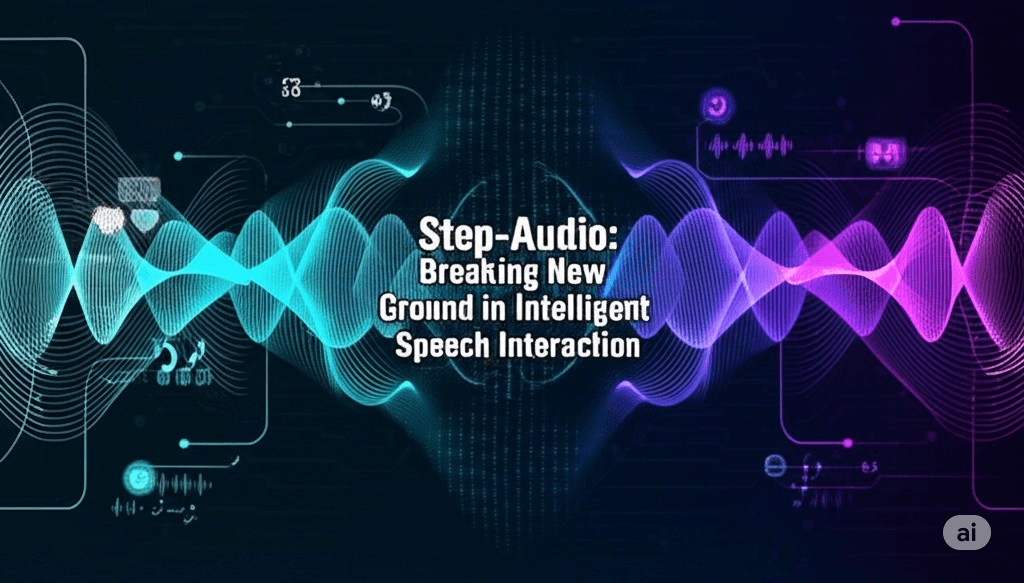Step-Audio: Breaking New Ground in Intelligent Speech Interaction
Imagine having a conversation with an AI that doesn't just understand what you're saying, but responds with the perfect tone, emotion, and even speaks in different dialects or breaks into song when needed. This isn't science fiction—it's what researchers at StepFun have achieved with Step-Audio, a groundbreaking open-source framework that's setting new standards for real-time speech interaction.
The Challenge: Beyond Simple Voice Commands
Current AI speech systems face a fundamental problem: they're fragmented. Traditional approaches chain together separate components—one for understanding speech, another for processing language, and a third for generating responses. This creates a cascade of errors, delays, and awkward interactions that feel distinctly robotic.
Even more challenging is the data problem. Creating high-quality speech datasets requires enormous human effort, especially for different languages, dialects, and emotional expressions. Most existing systems also lack sophisticated control mechanisms—they can't dynamically adjust speaking rate, switch between dialects, or handle complex requests like "Get the weather forecast and tell me in Cantonese with a cheerful tone."
The Innovation: A Unified Approach
Step-Audio solves these problems through an elegant unified architecture built around a massive 130-billion parameter model that simultaneously understands and generates speech. Think of it as giving an AI a complete understanding of language in all its forms—written, spoken, emotional, and musical.
The Dual-Codebook Revolution
At the heart of Step-Audio lies an innovative dual-codebook tokenization system. Instead of using a single approach to convert speech into computer-understandable tokens, the system uses two complementary methods:
- Linguistic tokens capture the structural elements—phonemes, words, and grammar
- Semantic tokens preserve meaning and acoustic characteristics like tone and emotion
This dual approach is like having both a transcript and an emotional/tonal map of speech, allowing the system to maintain both meaning and expressiveness when generating responses.
A Data Engine That Creates Its Own Training Material
Perhaps most remarkably, Step-Audio includes a "generative data engine" that essentially teaches itself. Instead of requiring massive manual annotation efforts, the system can generate high-quality training data for new voices, languages, and speaking styles. This breakthrough dramatically reduces the cost and time needed to expand the system's capabilities.
Capabilities That Push Boundaries
The results are impressive across multiple dimensions:
Multilingual and Dialect Mastery: Step-Audio can seamlessly switch between languages and dialects, including Cantonese and Sichuanese, maintaining native-like pronunciation and cultural nuances.
Emotional Intelligence: The system doesn't just recognize emotions—it can generate speech with specific emotional characteristics ranging from joy and anger to sadness, with five different intensity levels for each emotion.
Musical Abilities: Step-Audio can generate singing and rap vocals with accurate pitch control, rhythm, and harmonious output, opening new possibilities for creative applications.
Real-time Tool Integration: The system can simultaneously handle complex queries that require external data (like weather information) while maintaining natural conversation flow through asynchronous processing.
Performance That Sets New Standards
When tested against existing open-source models like GLM-4-Voice and Qwen2-Audio, Step-Audio achieved remarkable improvements:
- 43.2% better factual accuracy
- 23.7% improvement in response relevance
- 29.8% better instruction following
- 27.1% higher overall quality scores
On standard benchmarks, Step-Audio showed an average 9.3% performance improvement, with particularly strong results on complex reasoning tasks.
Technical Architecture: Engineering Excellence
The system's real-time performance comes from sophisticated engineering innovations:
Speculative Response Generation: The system begins preparing responses during natural pauses in conversation, reducing latency by approximately 500 milliseconds.
Streaming Audio Processing: Input audio is processed in real-time through parallel pipelines, enabling immediate response without waiting for complete utterances.
Context Management: The system maintains conversation history efficiently, supporting longer dialogues without performance degradation.
Training at Scale: A Three-Stage Journey
Step-Audio's training involved processing an enormous 3.3 trillion tokens across audio, text, and image data—equivalent to analyzing thousands of hours of speech and millions of documents. The training progressed through three carefully orchestrated stages:
- Foundation: Basic audio-text alignment using 2:1:1 ratios of audio, text, and image data
- Integration: Adding audio-text interleaved data for better understanding
- Specialization: Incorporating ASR and TTS data for production-ready performance
Real-World Impact and Applications
Step-Audio's capabilities open doors to numerous applications:
- Customer Service: Natural, emotionally appropriate responses in multiple languages
- Education: Adaptive tutoring that adjusts tone and complexity based on student needs
- Entertainment: Interactive storytelling with dynamic character voices
- Accessibility: High-quality speech synthesis for assistive technologies
Looking Forward: The Future of Voice AI
The researchers haven't stopped here. Future developments include expanding to full trimodal systems (incorporating vision alongside speech and text), improving pure voice dialogue efficiency, and enhancing tool-calling capabilities for even smarter interactions.
The Open Source Advantage
By making Step-Audio open source, StepFun is democratizing access to state-of-the-art speech technology. This means researchers, developers, and organizations worldwide can build upon this foundation, potentially accelerating innovation across the entire field.
Step-Audio represents more than just another AI model—it's a comprehensive rethinking of how machines can communicate with humans. By unifying understanding and generation, incorporating emotional intelligence, and enabling real-time interaction, it brings us significantly closer to natural, human-like AI communication.
The implications extend far beyond technical achievements. Step-Audio suggests a future where the barriers between human and machine communication continue to dissolve, creating more intuitive, accessible, and useful AI interactions for everyone.
